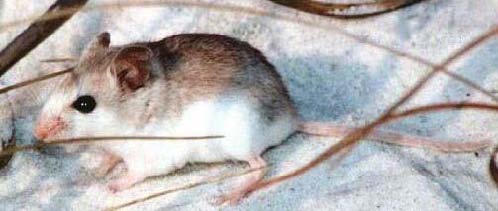Beach mouse - St Andrew
Photo Credit: Florida Fish and Wildlife Conservation Commission
Scientific Family Cricetidae
Scientific Name Peromyscus polionotus
Spanish Name
Fawn-colored upperparts and gray to white underparts through most of its range, but on white sandy beaches, the mouse is light or even white. Inland populations are darker and smaller with shorter tails that are dusky above and white below. General body and tail color may vary slightly depending upon geographical location. There are five subspecies: Alabama beach mouse (P. p. ammobates) lived on the Fort Morgan Peninsula on the Alabama Gulf coast, and extended from Ono Island to Fort Morgan, AL; Perdido Key beach mouse (P. p. trissyllepsis), Santa Rosa Island beach mouse (P. p. lecuocephalus), Choctawhatchee beach mouse (P. p. allophrys), and the Saint Andrews beach mouse (P. p. peninsularis).
Biology
Beach mice are coast sand dune specialist that are subspecies of the Old field mouse that occurs inland. They eat various plant seeds and insects, and prefer sand-covered slopes with patches of sea oats, beach grass, and other grasses and herbs. They play an important ecological role by collecting and distributing seeds that grow into plants which help to stabilize dunes. Beach mice are heavily impacted by human intervention, and the fragmenting and removal of dunes in coastal environments have caused severe population declines in many subspecies. Outdoor domestic cats can threaten these small mouse populations. The pallid beach mouse went extinct in 1978, the Perdido key beach mouse is critically endangered, The Alabama, St. Andrew's, and Choctawhatchee beach mice are endangered. Santa Rosa Island beach mice are not imperiled. These mice are very shy and are not often seen by beach goers. They often forage at night on dune vegetation.
Gulfsee life Projects related to Beach mouse - St Andrew
Appearance
Body Covering
Fur
Body Length
5 inches (12.7 cm
Tail Length / Leg Length
Long / Shorter
Fur Pattern
White belly
Fur Color
Brown
Tail Ratio
Specifications
Conservation Concerns
Most coastal subspecies are endangered
Range in USA
FL-AL
Abundance

 St Andrew Beach Mouse
St Andrew Beach Mouse

